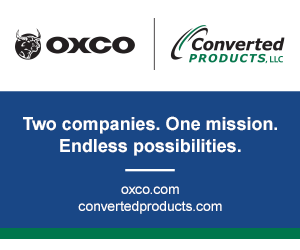On Print | UV/EB Inkjet for Food Packaging
- Published: May 12, 2015, By Dene Taylor
 Dene Taylor, a presenter at RadTech’s UV/EB West 2015, says packaging printed with energy cure inkjet may be coming soon to a supermarket near you.
Dene Taylor, a presenter at RadTech’s UV/EB West 2015, says packaging printed with energy cure inkjet may be coming soon to a supermarket near you.
Ultraviolet (UV) inkjet is a highly versatile printing technology. It gives good print quality from 2 in. to 10 ft wide and currently up to a speed of 300 fpm. As for productivity, no other digital process can compare.
UV inkjet printing is used to print or decorate a very wide range of label facestocks, including all primary packaging substrates. Given its demonstrated performance with labels, the adoption of this technique for packaging should naturally follow, especially considering that the same drivers for short run printing already exist. But this is not so.
One of the factors that may contribute to this situation is an economic one. The cost to differentiate generic packaging using labels is considerably less than the cost of printing different packaging. Other factors may be that the label supply chain is simpler, and also that—especially with food and household goods—there is concern that the contents might be chemically contaminated. This concern was central to the session on UV inkjet printing at RadTech’s recent UV/EB West conference.
LOW Migration CHEMICALS AND INK
The monomers and other reactive compounds used to formulate inks for UV and electron beam (EB) cure are, like many materials used to manufacture packaging, not wanted in food. Packaging companies and packaging printers are expected to ensure these compounds are not found there. They must be able to demonstrate compliance to the regulations that set limits for the presence of chemicals in food.
On the other hand, energy curing (UV and EB) has substantial benefits regarding sustainability, effects on air quality and cost, and has been used safely for years. EB cure offset printing dominates ice cream cartons and some other food packaging sectors.
Obviously, contamination can occur due to incomplete cure or the presence of mobile residues in cured ink. The two routes that would allow transfer to contents are:
- Offsetting to the back side of the substrate after printing (or coating)
- Migration through the package
EB cure offset formulating was comparatively straightforward. Offset inks have high viscosity, so monomers can be very large, which, in turn, means any migration will be slow, and vapor pressure is low, minimizing odors. Large monomers can have multiple reactive groups, so they will become part of the polymer on curing, a great advantage given that, for obvious reasons, polymers don’t move. Additionally, the cure rates for EB are high. The only drawback of EB offset is that its equipment costs more than that for UV cure.
For food packaging, UV cure’s dependence on photoinitiators is a drawback. And its crosslinking is less complete than EB’s. UV inkjet is further complicated in that ink must have very low viscosity. It depends on small compounds, which are inherently far more mobile by diffusion, contact, or as vapor.
At UV/EB West, Dr. Roel De Mondt from Agfa presented an update on UV inkjet inks formulated for food packaging, and Dr. Jo Ann Arceneaux from Allnex USA described several developments in the chemicals used by the ink companies. Both presenters discussed low odor and low migration chemicals and inks.
Odors, they argue, are especially problematic. The chemicals causing the odor may have low toxicity and be present well below permitted levels, but regardless of this, chemical smells in food are a consumer turnoff. Steps to eliminate odor sources include:
- Using starting materials without by-products of earlier reactions
- Processing for higher yield
- Rigorously stripping volatile compounds during monomer purification.
New multifunction monomers of comparatively low viscosity also help in diminishing the odor by tightening the polymer matrix. Traditional photoinitiators have mobile residues. For low migration inks, photoinitiators with crosslinking function are now the norm.
The packaging examples discussed in the presentation were plastic containers —polyester beverage bottles and polypropylene tubs for dairy products. Both polymers are moderately good barriers to organic compounds, so other potential applications can be assumed. For example, metallized films are very good barriers and so should perform well also.
Can these inks be used with polyethylene, the inner surface of most food pouches? Polyethylene is a poor barrier to small organic compounds, so I suggest we need inks especially formulated for no-migration, inks with extractable residues below regulatory thresholds when tested in direct contact with simulated food, even if used only for packaging where any contact is indirect. No-migration will be easier to sell, not just for packaging, but also where there may be incidental skin contact.
Another development was suggested by Dr. Arceneaux. Latex or emulsion inks are now commonly used for inkjet graphic arts printing. They have low viscosity from the water phase. UV cure formulations are prepared as emulsions for other uses. As emulsions, they can be made with high molecular weight, multi-functional compounds whose viscosity is otherwise too high.
Traditional UV cure is done with mercury vapor lamps. These lamps lose power continually so the degree of cure can fall off, too. LED lamps last at least ten times longer, maintaining the required intensity almost constant. When LEDs fail, they do not light. And LED formulations can be as resistant to component migration as both mercury vapor UV and EB inks, according to tests described at UV/EB West by Dr. Don Duncan of Wikoff Color.
The first thought that comes to mind when discussing EB cure is that the capital cost is too high. However, when a process permits doing something that couldn’t be done before, the economics are different. Until now, EB equipment has been too bulky for inkjet. But industrial printing is different. If EB is used for offset printing, then it should be natural to consider it with industrial digital. And that is the message we got from Sean Evans of Amgraph Packaging, a printer almost totally reliant on EB cure. His customers would like a complementary digital option, a process of similar width and good productivity. Only UV inkjet can provide this today. However, photoinitiators are unwanted. His desire for an EB cure inkjet system might soon be met—according to Dr. Steve Lapin of PCT Engineered Systems, a manufacturer of compact EB cure systems, a demonstration may be expected later this year.
Given these advances in chemicals and inks, with differentiation between applications based on substrate barriers, and cure using LED lamps or electron beam, packaging printed with energy cure inkjet may be showing up soon at a supermarket near you.
Printing expert Dene Taylor, PhD, founded Specialty Papers & Films Inc. (SPF-Inc.), New Hope, PA, in 2000 for clients seeking consultation for technical management, new product design, development, commercialization, and distribution, as well as locating/managing outsourced manufacturing. Contact him at 215-862-9434; dene@spf-inc.com; www.spf-inc.com.










